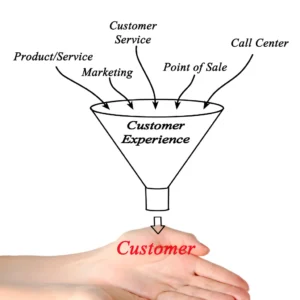
AI Tools for Retail B2C Industry
Transforming Retail Brilliance with Innovative Toolsets
This comprehensive article “AI Tools for Retail B2C Industry” delves into diverse AI tools spanning customer experience, inventory management, marketing, and more. Each tool addresses specific facets of retail operations, from personalized product recommendations to fraud prevention algorithms.
In the dynamic landscape of Retail B2C, integrating Artificial Intelligence (AI) toolsets has emerged as a game-changer, revolutionizing how businesses engage with customers, manage operations, and stay competitive.
We explore the intricate requirements for development, the technical knowledge essential for implementation, and the critical need for staff training to effectively navigate these transformative technologies.
Despite the challenges and costs involved, the potential benefits in terms of operational efficiency, enhanced customer satisfaction, and strategic market positioning underscore the profound impact of AI in reshaping the future of retail.
Table of Contents

Arindam Roy
An Automation Consultant with 25+ years of IT Experience
Business Knowledge Requirements
Industry Understanding:
To embark on developing AI tools for the Retail B2C industry, a profound understanding of the retail landscape is crucial. This involves knowledge of industry trends, consumer behaviour, and competitive market dynamics. Recognizing the challenges and opportunities within the retail sector is vital for crafting AI solutions that effectively address the unique demands of B2C retail businesses.
Data Management and Integration:
Comprehensive knowledge of data management is paramount. This includes understanding the diverse data sources within retail, such as customer databases, inventory systems, and sales records. Expertise in integrating and harmonizing these data sets is necessary to ensure that AI algorithms receive accurate and up-to-date information for decision-making processes.
Supply Chain Expertise:
Given the significant impact of supply chain management on retail operations, a deep understanding of supply chain principles is essential. This involves knowledge of inventory control, demand forecasting, logistics, and supplier relationships. Practical AI tools in this domain require insights into the intricacies of supply chain optimization and risk management.
E-commerce Dynamics:
For tools related to sales, conversion optimization, and customer experience, a firm grasp of e-commerce dynamics is imperative. This encompasses knowledge of online consumer behaviour, e-commerce platforms, payment gateways, and digital marketing strategies. Understanding the nuances of online retailing will inform the development of AI solutions tailored to the specifics of the e-commerce landscape.
Regulatory and Security Compliance:
In the retail industry, complying with regulations and ensuring data security is paramount. These two aspects are crucial for maintaining customers’ trust and avoiding unwanted legal consequences. Knowledge of relevant legal frameworks, such as consumer protection laws and data privacy regulations, is critical. Additionally, understanding cybersecurity threats and implementing measures for fraud prevention aligns with the need for secure and compliant AI solutions.
Customer Relationship Management (CRM):
Practical customer engagement tools require a robust understanding of CRM principles. Knowledge of how to leverage CRM systems to manage customer interactions, preferences, and feedback is essential. This knowledge enables the development of AI-driven tools that seamlessly integrate with existing CRM infrastructure, enhancing customer relationship management.
Retail Marketing Strategies:
Tools focused on marketing and advertising demand insights into retail marketing strategies. Understanding segmentation, targeted promotions, and the role of social media in shaping brand perception are crucial. This knowledge forms the foundation for creating AI tools that optimize marketing campaigns, personalize content, and analyze campaign performance.
User Experience (UX) Design:
For tools related to customer interaction, from chatbots to virtual try-ons, a deep understanding of UX design principles is indispensable. Intuitive interfaces, smooth navigation, and user-centric design contribute to the success of AI tools in enhancing customer experience and engagement.
Sustainability Awareness:
Incorporating sustainable product recommendations requires awareness of environmental concerns and consumer preferences for eco-friendly products. Understanding the sustainability landscape enables the integration of AI algorithms that align with business goals and ecological consciousness.
Business Analytics and Strategy:
Finally, a strong foundation in business analytics and strategy is vital. This involves interpreting analytics data, making informed business decisions, and aligning AI tools with overarching business objectives. Strategic thinking ensures that AI solutions contribute to the long-term success and growth of the retail business.
Technical Knowledge Requirements
Data Science and Machine Learning:
A robust data science and machine learning foundation is fundamental for developing AI Tools for Retail B2C Industry. This includes expertise in statistical analysis, predictive modelling, and algorithm development. Knowing machine learning frameworks like TensorFlow or PyTorch is crucial for implementing AI-driven functionalities such as predictive analytics and recommendation engines.
Natural Language Processing (NLP):
Proficiency in NLP is crucial for tools involving virtual shopping assistants, chatbots, and customer support. Understanding how to process and analyze human language, including sentiment analysis and entity recognition, enables the creation of effective and responsive AI systems to understand and generate human-like text.
Computer Vision:
Incorporating visual search and recognition functionalities demands expertise in computer vision. Knowledge of image recognition algorithms, object detection, and image classification is necessary. This technical skill set allows for the development of AI tools that enable customers to search and find products using images.
Big Data Technologies:
Given the vast amount of data generated in retail, familiarity with big data technologies is essential. Proficiency in tools such as Apache Hadoop and Apache Spark enables the processing and analysis of large datasets for demand forecasting, inventory optimization, and other data-intensive tasks.
Cloud Computing:
Scalability and flexibility are paramount in AI applications. Technical knowledge of cloud computing platforms like AWS, Azure, or Google Cloud facilitates the deployment and management of AI tools. Cloud services provide the necessary infrastructure for real-time processing, storage, and accessibility.
Software Development and Integration:
Sound knowledge of software development practices is necessary for building seamless and integrated AI tools. This involves proficiency in programming languages like Python, Java, or C++. Integrating AI tools with other components in the retail ecosystem requires integration with existing systems, databases, and APIs.
Cybersecurity and Fraud Prevention:
Developing tools for fraud detection and security requires a deep understanding of cybersecurity. Knowledge of encryption techniques, secure authentication methods, and real-time monitoring for anomalies in transaction patterns is crucial for implementing effective fraud prevention measures.
User Interface (UI) and User Experience (UX) Design:
A strong background in UI and UX design is necessary for tools focused on customer interaction. Technical expertise in visually appealing and user-friendly interfaces enhances the overall customer experience. Knowledge of design principles and front-end development is essential for crafting intuitive AI-powered interfaces.
Blockchain Technology:
Incorporating blockchain for supply chain transparency demands technical knowledge of distributed ledger technology. Understanding smart contracts, decentralized consensus mechanisms, and secure data sharing is crucial for implementing transparent and traceable supply chain systems.
IoT Integration:
For tools related to inventory health monitoring and real-time sales dashboards, knowledge of IoT (Internet of Things) integration is beneficial. Connecting sensors, RFID systems, and IoT devices to the AI infrastructure enhances real-time data collection and analytics capabilities.
Integration needs of AI Tools for Retail B2C Industry
Data Integration:
After building AI tools for the Retail B2C industry, one of the primary integration needs is data integration. The tools, from personalized product recommendations to inventory management, rely on diverse data sources. Integration with existing databases, CRM systems, and data warehouses is essential to ensure that the AI tools have access to accurate and up-to-date information. This seamless data integration guarantees the effectiveness of the tools in providing real-time insights and personalized experiences.
API Integrations:
Many AI tools, such as chatbots, virtual shopping assistants, and fraud prevention systems, require integration with external services through APIs. Connecting with payment gateways, e-commerce platforms, and external data sources enables these tools to function cohesively within the broader retail ecosystem. Establishing robust API integrations ensures smooth communication and data flow between the AI tools and external systems.
E-commerce Platform Integration:
For tools related to sales, conversion optimization, and customer experience, integration with e-commerce platforms is crucial. Seamless integration with platforms like Shopify, Magento, or others ensures that AI-driven functionalities align with the existing infrastructure of the online store. This integration streamlines the customer journey, from product discovery to checkout, enhancing the overall e-commerce experience.
CRM Integration:
Tools focusing on customer relationship management and predictive analytics require integration with CRM systems. Integrating AI-driven insights into the CRM platform gives businesses a unified view of customer data. This integration aids in personalized marketing, targeted promotions, and enhanced customer communication based on the predictive analytics generated by the AI tools.
Cloud Service Integration:
AI tools often leverage cloud computing resources for scalability and flexibility. Integration with cloud services such as AWS, Azure, or Google Cloud ensures that the AI tools can be efficiently deployed and scaled based on demand. This integration also facilitates the secure storage and retrieval of large datasets, supporting data-intensive processes like machine learning model training.
Security and Compliance Integration:
After building AI tools, integrating security measures and compliance protocols is imperative. This includes incorporating cybersecurity tools, identity verification services, and compliance frameworks to protect customer data and adhere to industry regulations. In today’s digital age, overlooking the importance of regularly monitoring and updating your security measures can lead to dire consequences. It is essential to remain vigilant against evolving security threats and protect yourself from potential cyber-attacks. Don’t leave your safety and security to chance – make it a priority to keep your defences current. It is also critical to stay informed about regulatory changes affecting security protocols.
User Interface and Experience Integration:
Integrating AI-powered features seamlessly into the user interface is crucial for customer interaction tools. UX designers and developers must collaborate for a cohesive and intuitive user experience. This means aligning virtual try-ons, chatbots, and other customer-facing features with overall design principles. Collaboration between the two is vital to achieve this goal.
IoT Device Integration:
In tools related to inventory monitoring and real-time sales dashboards, integration with IoT devices and sensors is necessary. Connecting RFID systems, temperature sensors, and other IoT devices ensures that the AI tools receive accurate and timely data. This integration enhances the overall efficiency of inventory management and sales analytics.
Supply Chain and Logistics Integration:
Integration with supply chain management systems and logistics platforms is crucial for tools addressing supply chain visibility and optimization. Connecting AI tools with these systems enables the optimization of routes, efficient inventory management, and seamless coordination with suppliers, contributing to a resilient and responsive supply chain.
Continuous Improvement Integration:
Integration also needs to extend to the continuous improvement of AI models. Implementing feedback loops, A/B testing frameworks, and mechanisms for model retraining based on new data are essential. This integration ensures that the AI tools evolve with changing customer behaviour, market dynamics, and business requirements, maintaining their effectiveness over time.
Technology Available for AI Tools
AI and Machine Learning Libraries:
The availability of AI and machine learning libraries is crucial for developing tools in the Retail B2C industry. Pre-built models and functions in widely used libraries like TensorFlow, PyTorch, and scikit-learn can expedite development. These libraries facilitate recommendation systems, predictive analytics, and natural language processing.
Cloud Computing Platforms:
Access to robust cloud computing platforms is essential for the scalability and efficiency of AI tools. Platforms like Amazon Web Services (AWS), Microsoft Azure, and Google Cloud offer various services, including computing power, storage, and data analytics tools. Leveraging these platforms allows developers to build and deploy AI solutions without significant infrastructure overhead.
Natural Language Processing APIs:
The availability of Natural Language Processing (NLP) APIs is vital to implementing AI-driven virtual shopping assistants and chatbots. Services like Google Cloud Natural Language API or Microsoft Azure Text Analytics provide pre-trained models for sentiment analysis, entity recognition, and language understanding, enabling the rapid development of AI-powered conversational interfaces.
Computer Vision APIs:
For tools involving visual search and recognition, computer vision APIs play a crucial role. Platforms like Google Cloud Vision API or Microsoft Azure Computer Vision offer pre-trained models for image classification, object detection, and facial recognition. Integrating these APIs accelerates the development of AI tools with image recognition capabilities.
Big Data Technologies:
The availability of big data technologies, such as Apache Hadoop and Apache Spark, is essential for handling large datasets in retail. These technologies provide:
- Distributed computing capabilities.
- Developers can use the tools provided to process and analyze large amounts of data, enabling them to forecast demand accurately.
- Inventory optimization.
- Other data-intensive tasks.
Blockchain Platforms:
Access to blockchain platforms is necessary to implement transparency and traceability in the supply chain. Platforms like Ethereum or Hyperledger provide the infrastructure for creating secure, decentralized ledgers. These platforms enable the implementation of transparent and tamper-proof supply chain systems.
IoT Devices and Sensors:
For tools related to inventory health monitoring and real-time sales dashboards, the availability of IoT devices and sensors is crucial. Connecting RFID systems, temperature sensors, and IoT devices to the AI infrastructure enhances real-time data collection, providing accurate inventory and sales performance insights.
E-commerce Platforms and APIs:
Integration with e-commerce platforms and APIs is essential for tools focused on sales, conversion optimization, and customer experience. Access to platforms like Shopify, Magento, or WooCommerce allows developers to seamlessly incorporate AI functionalities into existing e-commerce systems, enhancing the overall shopping experience.
Cybersecurity Tools:
The availability of cybersecurity tools and platforms is crucial for implementing fraud prevention measures. Utilizing tools for real-time monitoring, threat detection, and encryption ensures the security of transactions and customer data, safeguarding the retail ecosystem from potential cyber threats.
User Interface (UI) and User Experience (UX) Design Tools:
The availability of UI and UX design tools is essential for tools focused on customer interaction. Design tools like Figma, Adobe XD, or Sketch aid in creating visually appealing and user-friendly interfaces. These tools contribute to developing AI-powered interfaces that enhance the overall user experience.
Training Needs for existing staff to manage the AI Tools for Retail B2C Industry
Understanding AI Concepts:
Given the sophisticated nature of AI tools, existing staff needs comprehensive training on fundamental AI concepts. This includes understanding machine learning principles, algorithms, and the role of AI in the Retail B2C context. Training sessions should cover the basics of how recommendation engines work, the principles behind predictive analytics, and the integration of AI into daily operations.
Tool-specific Training:
Staff members must undergo specialized training on each AI tool deployed in the retail environment. This involves in-depth knowledge of operating, configuring, and utilizing the tools effectively. Training should cover the functionalities of personalized product recommendation engines, virtual shopping assistants, and other AI-driven systems to empower staff with the skills needed to manage and optimize these tools.
Data Management Training:
Considering the central role of data in AI applications, staff members need training in data management practices. This includes understanding how to input, clean, and maintain data integrity for the AI tools to function optimally. Training on data security and privacy measures is essential to ensure compliance with regulations and safeguard customer information.
Integration Training:
When integrating AI tools into existing systems, staff must receive training on managing these integrations. For the staff to make the most of the available tools, they must be adequately trained. This will enable them to incorporate the tools into their work smoothly and take advantage of their benefits. The language used during the training should be simple and easily understandable, without any complex jargon, acronyms or legal terminology. This involves understanding the data flow between AI tools and other platforms, troubleshooting integration issues, and ensuring the seamless interoperability of AI tools with the broader retail infrastructure.
User Interface and Experience Training:
Training on managing AI-powered interfaces is essential for staff responsible for customer interaction and user experience. This includes understanding how to operate virtual try-on systems, interact with chatbots, and assist customers using AI-driven tools. Training should emphasize delivering a positive and cohesive user experience through these technologies.
Security Training:
Given the importance of cybersecurity in retail operations, staff members need training on maintaining the security of AI tools and associated data. This involves understanding best practices for identity verification, fraud prevention, and ensuring the confidentiality of sensitive information. Continuous training on emerging cybersecurity threats is vital for proactive risk mitigation.
Analytics and Reporting Training:
In analytics and reporting functions, staff should receive training on interpreting insights generated by AI tools. This includes understanding real-time sales dashboards, predictive sales forecasting, and customer journey analytics. Training should empower staff to leverage AI-generated insights for informed decision-making and strategic planning.
Continuous Learning Programs:
Employees must participate in continuous learning programs to stay updated on AI technologies and industry trends. This involves periodic training sessions, workshops, and access to resources that inform staff about new features, improvements, and emerging applications in the AI domain.
Customer Interaction Training:
Specific training on effective interaction with AI-driven tools is necessary for staff involved in customer-facing roles. This includes guiding customers through virtual try-ons, assisting with chatbot interactions, and using AI tools to enhance the overall customer experience. Training should focus on developing soft skills to complement the technical aspects of AI interaction.
Feedback Mechanism Training:
Implementing an effective feedback mechanism is crucial for continuous improvement. Staff should be trained in collecting and interpreting customer feedback related to AI tools. Understanding how to convey feedback to the development team for further optimization ensures that the AI tools align with customer expectations and business goals.
Challenges and Workarounds for AI Tools Implementation
Data Quality and Availability
Challenge:
The effectiveness of AI tools relies heavily on the quality and availability of data. Consistent data quality and gaps in data availability can lead to accurate predictions and suboptimal performance.
Workaround:
Implement robust data governance practices to ensure data quality. Regularly audit and clean datasets to eliminate inconsistencies. Invest in data collection strategies and explore alternative data sources to address gaps.
Integration Complexity
Challenge:
Integrating AI tools seamlessly with existing systems can be complex, especially in large and legacy retail environments. Compatibility issues and integration complexities may hinder the smooth operation of AI tools.
Workaround:
- Prioritize modular and scalable design during the development of AI tools.
- Use standardized APIs for integration, allowing for easier interoperability.
- Conduct thorough testing and have a dedicated integration team to address challenges promptly.
User Adoption Resistance
Challenge:
AI tools can be challenging if staff and customers need more understanding and trust in the technology.
Workaround:
- Implement comprehensive training programs for both staff and customers.
- Emphasize the benefits of AI tools, such as improved efficiency and personalized experiences.
- Encourage a gradual rollout, allowing users to acclimate to the new technologies.
Security Concerns
Challenge:
Integrating AI tools introduces security concerns, especially in handling sensitive customer data. Privacy breaches and vulnerabilities may pose significant risks.
Workaround:
- Prioritize robust cybersecurity measures, including encryption, secure authentication, and regular security audits.
- Ensure that data privacy is maintained by following the regulations and standards of the industry.
- Educate staff and customers about security measures to build trust.
Continuous Monitoring and Maintenance
Challenge:
AI tools require ongoing monitoring and maintenance to stay effective. Neglecting this aspect can lead to performance degradation and missed opportunities for improvement.
Workaround:
- Establish a dedicated maintenance team to monitor AI tools continuously.
- Implement automated alerts for potential issues.
- Regularly update models based on new data and advancements in AI technology.
Cost Implications
Challenge:
Implementing and maintaining AI tools can incur significant costs, including development, integration, and ongoing operational expenses.
Workaround:
- Conduct a thorough cost-benefit analysis before implementation.
- Consider phased rollouts to manage initial costs.
- Explore cloud-based solutions for scalability without high upfront infrastructure costs.
Ethical Considerations
Challenge:
AI tools, especially in customer-facing applications, raise ethical concerns regarding data privacy, bias, and transparency.
Workaround:
Incorporate ethical AI principles in the development process. Regularly audit algorithms for biases. Communicate how AI tools handle data, ensuring transparency and earning user trust.
Adapting to Changing Customer Behaviour
Challenge:
Customer behaviour evolves, and AI tools must adapt quickly to remain relevant. Failure to do so may result in outdated recommendations and experiences.
Workaround:
- It is essential to establish feedback mechanisms and loops to ensure continuous improvement.
- Regularly update AI models based on changing customer preferences and market trends.
- Stay agile and responsive to evolving consumer behaviour.
Regulatory Compliance
Challenge:
The retail industry is subject to various regulations, and ensuring compliance can be challenging when deploying AI tools.
Workaround:
Stay informed about relevant regulations and adapt AI tools to comply with data protection and consumer privacy laws. Engage legal experts to ensure compliance and proactively address regulatory changes.
Balancing Automation with Human Touch
Challenge:
While AI tools enhance efficiency, there’s a risk of diminishing the human touch in customer interactions.
Workaround:
- Design AI tools to complement, not replace, human interactions.
- Implement chatbots for routine queries, leaving complex issues to human support.
- Maintain a balance to provide a personalized and empathetic customer experience.
Cost Benefit analysis of AI Tools in Retail B2C Industry
Development Costs
Costs:
Creating AI tools for the Retail B2C industry requires significant money upfront. This includes hiring AI developers, data scientists, and domain experts. It also involves investing in technology infrastructure, software licenses, and development tools.
Benefits:
AI tools can justify initial development costs by improving operational efficiency, enhancing customer experiences, and gaining a competitive edge in retail. Streamline processes, reduce workload, and make better decisions with AI.
Integration Costs
Costs:
Integrating AI tools with existing systems may incur additional fees. This includes expenses related to adapting legacy systems, training staff, and addressing compatibility issues. Ongoing integration maintenance also contributes to the overall costs.
Benefits:
Integration costs outweigh the benefits of a cohesive and interconnected retail ecosystem. Integrated AI tools enhance data flow, provide real-time insights, and contribute to a seamless customer journey. The long-term operational efficiency gains justify the integration investment.
Operational and Maintenance Costs
Costs:
Regular maintenance, monitoring, and updates of AI tools contribute to ongoing operational costs. Costs may also include training staff, implementing security measures, and ensuring regulatory compliance.
Benefits:
Operational and maintenance costs are justified by sustained tool performance, adaptability to evolving market conditions, and the ability to proactively address security concerns. Regular updates and maintenance ensure that AI tools remain effective and aligned with business goals.
Training Costs
Costs:
Training staff on using and managing AI tools incurs costs, including training programs, materials, and potential productivity losses during the learning curve.
Benefits:
Employee training is essential to develop a highly skilled and capable workforce. Practical AI tool usage requires proper training to minimize errors, leading to better customer experiences and operational efficiency.
Hardware and Software Costs
Costs:
AI tools may require specialized hardware and software components, adding to the overall expenses. This includes high-performance computing resources, GPUs for machine learning tasks, and software licenses for proprietary tools.
Benefits:
Investing in appropriate hardware and software ensures the optimal functioning of AI tools. The enhanced processing power accelerates computations, leading to faster and more accurate results. The benefits include improved performance and responsiveness of AI-driven functionalities.
Customer Acquisition and Retention Benefits
Costs:
Implementing AI tools geared towards customer engagement incurs costs regarding promotional campaigns, personalized incentives, and loyalty programs.
Benefits:
The benefits lie in improved customer acquisition and retention. Personalized product recommendations, targeted marketing campaigns, and enhanced customer experiences contribute to increased customer satisfaction and loyalty, ultimately boosting revenue.
Competitive Advantage Benefits
Costs:
Staying competitive may require ongoing investment in AI technologies to keep up with industry trends and advancements.
Benefits:
The strategic advantage gained by leveraging AI tools justifies the continuous investment. Being at the forefront of technological innovation can attract tech-savvy consumers, enhance brand perception, and position the business as an industry leader.
Costs of Inaction
Costs:
Not investing in AI tools can lead to missed opportunities, operational inefficiencies, and an inability to meet evolving customer expectations.
Benefits:
AI tools can help businesses become more efficient, make better decisions, and adapt to market changes. Companies can use these tools to proactively tackle challenges, spot opportunities, and outpace their rivals.
Conclusion
In conclusion, integrating AI Tools for Retail B2C Industry represents a transformative leap toward operational efficiency, enhanced customer experiences, and sustainable growth. The diverse toolset, spanning customer engagement, inventory management, marketing, sales, customer support, fraud prevention, and more, underscores AI’s comprehensive impact on every facet of retail operations.
The journey begins with a robust understanding of the industry, its dynamics, and its challenges. The technical knowledge required for developing these tools encompasses data science, machine learning, cloud computing, and various other domains, while the availability of cutting-edge technologies facilitates their implementation.
However, this technological advancement has its challenges. From data quality concerns and integration complexities to ensuring ethical practices and user adoption, navigating these hurdles requires a strategic and multifaceted approach. Staff training emerges as a crucial component, empowering employees to effectively manage, utilize, and continuously optimize these AI tools.
The costs associated with creating and using these toolsets are noteworthy, encompassing development, integration, operational, and training expenses. Yet, the benefits are equally substantial. Enhanced operational efficiency, better decision-making, and customer satisfaction enable competitiveness in rapidly evolving markets, leading to higher ROI.
As retail businesses embrace the era of AI, it is not merely about adopting new technologies; it’s about orchestrating a transformation that aligns with customer expectations, market trends, and the ever-changing landscape of commerce. The symbiotic relationship between humans and AI tools is poised to define the future of retail, where innovation, adaptability, and customer-centricity reign supreme. The journey may be challenging, but the destination promises a retail landscape redefined by the power of artificial intelligence.
Related Articles
- AI Automation Tools in Brick-and-Mortar Retail Store
- AI Tools for Customer Feedback and Support in Retail B2C
- AI Tools for Marketing and Advertising in Retail B2C Industry
- AI Tools for Fraud Prevention and Security in Retail B2C
- AI Tools for Sales and Conversion Optimization in the Retail B2C
- AI Tools for Customer Loyalty and Retention in Retail B2C
- AI Tools for Analytics and Reporting in Retail B2C Industry
- AI Tools for Product Management and Innovation in Retail
- AI Tools for Supply Chain Visibility and Optimization in Retail
- AI Tools for Customer Experience and Engagement in Retail
- AI Tools for Inventory and Supply Chain Management for Retail
- AI in Retail Customer Experience
























